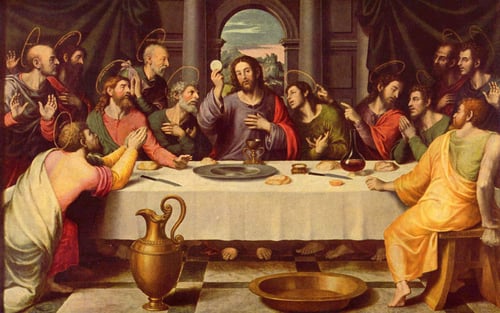
Today is Maundy Thursday — no, not Monday Thursday, which would be an interesting concept: society could work Monday through Thursday, with Fridays off! Some Christians misunderstand that this day is only a “Catholic” celebration. Christians both ancient and modern have remembered Christ’s last supper with his disciples on Maundy Thursday, which begins the great triduum, the three days of the paschal celebration.
The word “maundy” comes from the Latin word maundatum for “commandment”, which comes from Jesus’ words from the last supper: “I give you a new commandment; that you love one another…” The full Latin phase is maundatum novarum, which means “a new commandment.” According to Robert Webber (The Services of the Christian Year, #252), these words were translated in the French word mande. This in turn was anglicized into “maundy.”
During this day, Christians celebrate Jesus’ last supper with his disciples through serving and receiving communion with a special service. Often, all of or some of John 13 is read. This scripture recalls:
 The celebration of Passover
The celebration of Passover- The plan of betrayal against Jesus by Judas
- How washed his disciples feet
- Peter’s rejection of the washing, but then wants his hands and head washed
- Jesus told his disciples to wash one another’s feet
- The Last Supper
- The new commandment
Webber also teaches us the purpose and meaning of the Maundy Thursday worship service:
A primary meaning of this service is to celebrate the giving of the new commandment to love one another, a commandment given in the context of Jesus washing the disciple’s feet. When we celebrate this service, the covenant between God and ourselves is renewed, and we are made ready for his death and resurrection. The agape meal… symbolizes, as the meals in the Old Testament did, the relationship we have with God.
My church holds a worship service to remember Christ’s last days with his disciples. We gather, sing, show expressions of peace, hear the “new commandment”, and remember Christ’s last supper by being served “at the table” in sets of 12 people. As each person comes to the communion table, participants serve one another communion. This provides a deeper and intimate setting to receive the communion elements.
Maundy Thursday is the time in which we remember the final acts of Jesus and focus on Christ’s sacrifice for us. This is all done in order to achieve a more profound “Alleluia” for Easter morning.

 The celebration of Passover
The celebration of Passover